| Author |
 Topic Search Topic Search  Topic Options Topic Options
|
Mark Peterson 
Paid Member

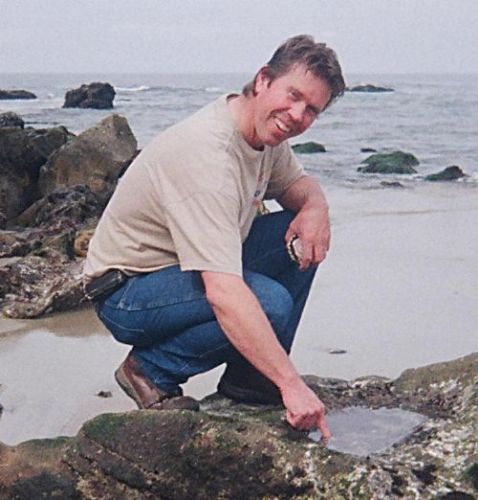
Joined: June 19 2002
Location: Murray
Status: Offline
Points: 21436
|
 Post Options Post Options
 Thanks(0) Thanks(0)
 Quote Quote  Reply Reply
 Topic: An affordable reef aquarium & Reefkeeping Tips Topic: An affordable reef aquarium & Reefkeeping Tips
Posted: November 26 2005 at 11:23pm |
(Reefkeping Tips > Please scroll down for the list of links to helpful forum discussions)
The affordable way to set up a Reef Aquarium is not a secret. Professionals have been using these methods for years. Even if your reef aquarium is already running, reading this information will help with understanding and may just save you from making some of the common and costly mistakes.
My fellow hobbyists, A-lo-ha 
I certainly made plenty of mistakes. I'm definitely no expert but I feel a need to share what I have learned over the years, since my first reef aquarium in 1993. Since then I have seen and/or maintained over 500 reef aquariums and helped countless other hobbyists way back to the 1995 founding of this wonderful WMAS. 
This initial post describes how to set up a lightly stocked reef aquarium according to the best biology available. It's all about the biology. so if you aren't fascinated by living things, stop right here. This hobby may not be for you. 
The Reefkeeping Tips at the bottom of this OP and posts further on in this thread describe other important time and money saving ideas.
UTAH SAND AND ROCK
Living in Utah provides access to practically free sand and rock. Cleaning Utah sand and rock is covered in the next post. Locating and collecting Utah sand is covered in a post a little further down and many posts and topics written in the years since. On the second page of this thread there is a map to the location where clean white Oolitic sand can be found. Do a search and/or ask in a new topic for hobbyists that would not mind sharing their extra sand and rock. Over the years, many hobbyists have tried but without proper collection and cleaning they have failed to have success with this sand and rock. Utah sand and Utah rock is available in SLC so there is no need to take a chance on finding the wrong stuff. Call/text Mark at 808-345-1049
AQUARIUM SET UP
The principles and methods described next apply to setting up any reef aquarium whatever type of sand and rock is used. Setup involves the use of four living components: LS, LR, LW, and Macroalgae. Setting up a reef tank in this way can actually skip the common waiting period; the traditional "cycling" you may have heard or read about. Simply put, the "cycle" is the processing of pollution that comes from dead and dieing things decomposing in the tank. The principles of biology used in the steps below mimic the creation of a world as recorded in Genesis. Science fiction calls it "Terra-Forming" It will practically avoid the pollution cycle, cleaning pollution as quickly as it forms.
This considers the use of live components. Next is an explanation of each:
LS = Live Sand. The sand isn't actually alive, there are bacteria, algae, worms, and other critters living in and on the sand.
LR = Live Rock. It's called "live" because bacteria, algae, worms and other critters live on and in the rock.
LW = Live Water. Bacteria, algae, invertebrate larvae and other microscopic life are suspended in the water of an existing, healthy reef aquarium.* * Bottled Bacteria in a liquid suspension is now available for supplementing the live bacteria of LS, LR, and LW and when used in conjunction is a very good thing.
Macroalgae = Types of plant-like algae which absorb waste. Caulerpa and Chaetomorpha (pronounced "kaulerpa" and "kate-o-morfa") are common macroalgae in the hobby. Here is a link to a thread with pics of many common Macroalgae, both the good ones  and the bad ones and the bad ones Types of Macroalgae (with pics) http://www.utahreefs.com/forum/forum_posts.asp?TID=5037 Types of Macroalgae (with pics) http://www.utahreefs.com/forum/forum_posts.asp?TID=5037
These four live items compose 70-90% of the filtration of a typical reef aquarium. In effect, these are the most important components of aquarium filtration. The greater the quantity of these components used in set-up, the sooner the tank can be ready for coral and fish.
Though slightly abbreviated, here are steps for setting up reef aquariums. I have used this method since around 1999. The method has been used for dozens of my own tanks and by countless hobbyists. If you have any questions along the way, don't hesitate to call. My phone number (as of this edit) is 808-345-1049.
DAY 1
1. Place 1/2 - 1" of screened and washed Oolitic Sand (refer to next post for Utah Oolitic Sand cleaning instructions) in the bottom of the tank. Caution when placing Oolitic sand: A big wet clod of sand can easily slip out of a bucket and crack the bottom glass of an empty aquarium.
2. Fill with LW to just cover the new sand. To prevent stirring up the sand, set a bucket lid or dinner plate on the sand and pour the water onto the lid/plate.
3. Add wet LS from an established reef tank for an additional 1/2 - 1" of depth on top of the Oolitic sand. If that much LS is not available, use rinsed CaribSea Special Grade Reef Sand or larger particle sand and as much LS as possible, even if it's just a few cups. Add LW to just cover the sand and place the LS in several small depressions. Completely covering the Oolitic sand with larger particle sand is useful because otherwise Oolitic sand can cause quite a dust storm when water is added and pumps are turned on. It can take up to 2 weeks for a biological film to begin holding the Oolitic sand together so it's not so dusty (inadequate rinsing sometimes leads to a dust storm of fine particles that take up to a week to disperse by sticking to the biofilm on other surfaces).
4. Add several more inches of LW.
5. Place previously prepared Utah Aragonite Rock/Lake Bonneville Tufa Rock (LBTR) as base rock (refer to next post for info regarding this rock). Try to set the bottom pieces on edge pushed partly into the sand for stability with second level pieces straddling the lower rocks. This ensures water flow over as much exposed sand as possible. Look in this thread a few posts down for some aquascaping tips: http://www.utahreefs.com/forum/forum_posts.asp?TID=38324
6. Add more LW and newly mixed saltwater to fill the tank at least 3/4 full.
7. Place selected pieces of LR, preferably kept submerged when moved from another hobbyists tank, on top of the first and second tiers of LBTR. If it was not possible to transport the LR submerged, or if the LR was purchased from the LFS, be sure to twist turn and shake it to get all possible air out of the pores. (Air kills marinelife, thus requiring many weeks for decomposition/cycling/recovery. See the Reefkeeping Tip below on how to best move LR.)
8. Finish filling the tank with LW or freshly mixed saltwater and pour in some bottled bacteria. There are many brands. All are good products for supplementing bacteria in addition to that already living in the LS, LR and LW.
9. Place Macroalgae in the aquarium. Strands of Caulerpa and/or clumps of Chaetomorpha Macroalgae are usually available free from hobbyists in the WMAS on this forum. Various well lit positions in the tank are best for Macroalgae. The use of Macroalgae is part of the key to setting up a livable tank as quickly as possible.
10. Place and plug in the pumps. Position water flows to push water up from the bottom up to create a surface water rippling effect. This roiling or rippling effect aerates the water. Aeration gets air to the coral and fish so they can breath. Leave the top of the tank open as much as possible so it can breathe. (This is also called "gas exchange".)
That's about it for day one. Leave the lights on as long as possible, all night if possible. We want algae to grow immediately to filter the polluting Nitrogen compounds (Ammonia, Nitrite and Nitrate) produced by bacteria as decomposition begins. Regarding the lights, here's a good thread explaining why the lights should be ON: http://utahreefs.com/forum/forum_posts.asp?TID=78757
DAYS 2, 3 & 4
Add a few soft coral frags.
DAYS 5, 6 & 7
If the coral frags have been expanding and showing polyps, add a few Snails, and a Hermit Crab or two and a couple Green Chromis Damselfish or even saltwater Mollies. The number of snails hermits and fish added at this point depends on the size of the tank and the amount of LS, LW, LR and Macroalgae used.
More snails should be added over the coming weeks as more soft algae begins to grow on rock and glass. Golden brown Diatom algae and sometimes Dinoflagellate algae are first to appear. This is a normal part of new tank growth. Regarding the numbers and importance of Snails and Hermits, see the related thread here and linked below in the Tips section. http://utahreefs.com/forum/forum_posts.asp?TID=37548
This is a good start. More coral and fish can be added in the following weeks, but be cautious of adding fish and stony coral too quickly. Fish are water polluters. Coral are water filterers, but sensitive coral of the stony variety can die easily in a new tank (0-6 months). Anemones are also water polluters, sometimes even worse than fish. An anemone should not be tried for at least 2 months.
WATER QUALITY
Water changes for the newly set up aquarium are really no different than for an established and more mature reef aquarium. Simply put, a water change of 10% each month is sufficient for any properly set up and moderately stocked reef aquarium. There is much said, mostly by newer hobbyists about more frequent and/or larger water changes, but you will find that the more experienced hobbyists do ~10% water changes every 1-3 months. I believe that the key is to utilize sufficient biological filtration (LS, LR, and Macroalgae) to lessen the need for laborious water changes.
Cleaning the water of polluting Nitrogen compounds is as easy as leaving the lights shining on the algae 24 hrs per day for a few days or a week. This is as effective and definitely easier than doing large water changes.
Another important point is to learn the chemistry of the Reef Aquarium; Alkalinity(Alk), Calcium(Ca), Magnesium(Mg) and Nitrate(N) levels. These water parameters are equally as important as Temperature and Salinity. I recommend checking these parameters weekly through your LFS or by the purchase of test kits. If using the LFS, be sure to ask for the actual numbers. Don't accept their response that "everything is fine". More on this, in later posts, including how to make Alk and Ca additives from household items you may already be using for other purposes.
Please feel free to ask questions here and feel free to copy, print and utilize all of the information contained in this entire thread. It's my 2 cents worth of contribution to the hobby that I have loved and lived since 1993.  A FINAL POINT
One parting comment for posterity: Let us be thoughtful.  We need to know husbandry information before we bring it home,
because asking the question after the organism is having trouble in our tank is less than responsible. I am speaking to myself as well. In
September 1993 when I got into this hobby, I kept a list of the stuff I
bought and the stuff that died in my 55 gal. Eighteen months later I was a
lot smarter but carried so much remorse that I stopped keeping the list.
I had gone through almost $2000 worth of animals and what did I have
left? Two clownfish, a Yellow Tang, a Six-line Wrasse, snails, hermits
and an Ugly Green Haired Mermaid. http://www.garf.org/ugly.html We need to know husbandry information before we bring it home,
because asking the question after the organism is having trouble in our tank is less than responsible. I am speaking to myself as well. In
September 1993 when I got into this hobby, I kept a list of the stuff I
bought and the stuff that died in my 55 gal. Eighteen months later I was a
lot smarter but carried so much remorse that I stopped keeping the list.
I had gone through almost $2000 worth of animals and what did I have
left? Two clownfish, a Yellow Tang, a Six-line Wrasse, snails, hermits
and an Ugly Green Haired Mermaid. http://www.garf.org/ugly.html
Thanks
to the formation of the WMAS and thanks to LeRoy Headlee of GARF, my
reef was saved, I stopped killing so many animals and actually started farming marine animals. http://www.utahreefs.com/SeaStar/wmasSeaStar02Feb.pdf
I
am so thankful for the WMAS. I'm grateful to be one of it's six original and last remaining founding member from 1995. Over the years, I took the
time to visit hundreds of hobbyists, welcoming them to
the club and picking up tips from them whenever possible. I also helped
maintain over 200 reef aquariums while working for Mountain Shadow
Marine, the largest marine aquarium maintenance company in the
intermountain west.
 Mahalo for reading. I hope this helps. Feel free to call or text me at 808-345-1049. Mahalo for reading. I hope this helps. Feel free to call or text me at 808-345-1049.
Aloha,
Mark 
How to add images to posts in this forum:
Red Slime/Cyanobacteria of many colors, how to eradicate it:
Importance of Snails and Hermit Crabs
Heaters and water Temperature, what's best? http://utahreefs.com/forum/forum_posts.asp?TID=79571 ATO (automatic top-off) ? Best unit?
The final attempt to keep fish disease free if nothing else has worked:
Clownfish -  Can they get along? Can they get along?
Aquascaping tips How to make it look natural and beautiful. Also, how fish can be happy so they run for cover instead of jumping out of the tank:
Catching Fish the easy way: http://utahreefs.com/forum/forum_posts.asp?TID=29554
and another Aiptasia discussion with a great hobbyist tip on eradicating Majano  : :
Quick Reference list of How to's:
Pictures of just a few of my Reef Aquariums:
Edited by Mark Peterson - December 06 2016 at 4:56pm
|
Reefkeeping Tips, & quick, easy setup tricks:www.utahreefs.com/forum/forum_posts.asp?TID=9244 Pay it forward - become a paid WMAS member 
|
 |
Mark Peterson 
Paid Member


Joined: June 19 2002
Location: Murray
Status: Offline
Points: 21436
|
 Post Options Post Options
 Thanks(0) Thanks(0)
 Quote Quote  Reply Reply
 Posted: November 26 2005 at 11:24pm Posted: November 26 2005 at 11:24pm |
Utah has two resources that are perfect for setting up marine/reef aquariums. Oolitic sand and Lake Bonneville Tufa Rock (LBTR). See the pics below. But these free resources do not come ready to use. They require first the finding, then the collecting and then cleaning prior to use.[edit June 2013: sand and rock is now available in SLC. Call/text Mark at 808-345-1049]
1. Oolitic Sand
If dry, screen with a window screen or something similar to remove sticks, rocks, bullets , etc. Then rinse in tapwater about four times until the rinsewater turns from tan to a clear gray. Rinsing smaller amounts at a time is usually easier because of it's packing density. , etc. Then rinse in tapwater about four times until the rinsewater turns from tan to a clear gray. Rinsing smaller amounts at a time is usually easier because of it's packing density.

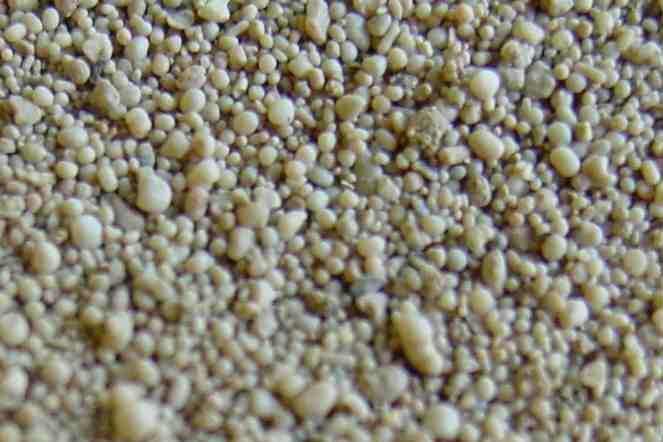
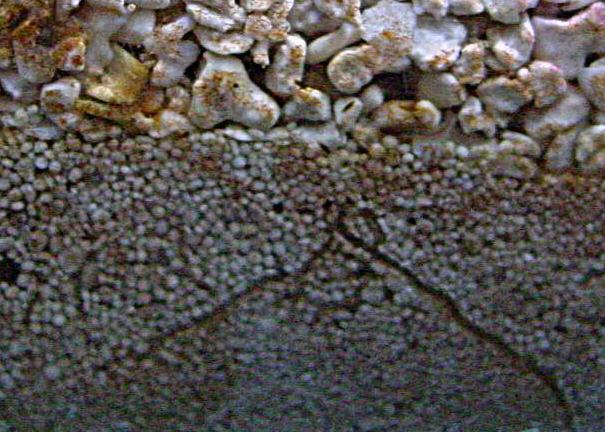
2. Utah Aragonite Rock/ Lake Bonneville Tufa Rock (LBTR)
Blast it on all sides at the carwash with the high pressure spray in the Rinse setting. Squeeze the handle. Try to blast off at least 95% of the lichen and moss from all surfaces. Placing the tip of the wand about 3" from the rock surface will get the toughest stuff. Blast all holes. There is dirt in some nice holes that cannot be opened up unless blasted by the high pressure spray. When it's done the clean LBTR is pretty much sterile with very little organic material to cause pollution. Large quantities of clean LBTR cause no problem in any tank, new or old.
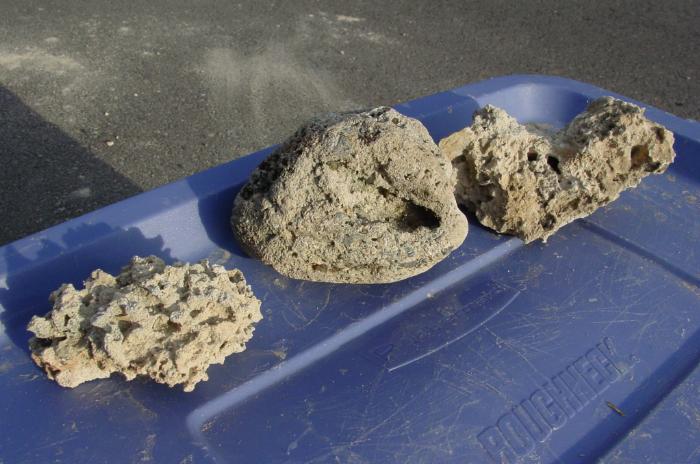
Above is how LBTR looks after picking it up off the ground. Below are a couple pics of LBTR in a tank that has been set up for 16 months. But for two exceptions, all the LR seen in these pics is 16 month LBTR. Can you find the exceptions?
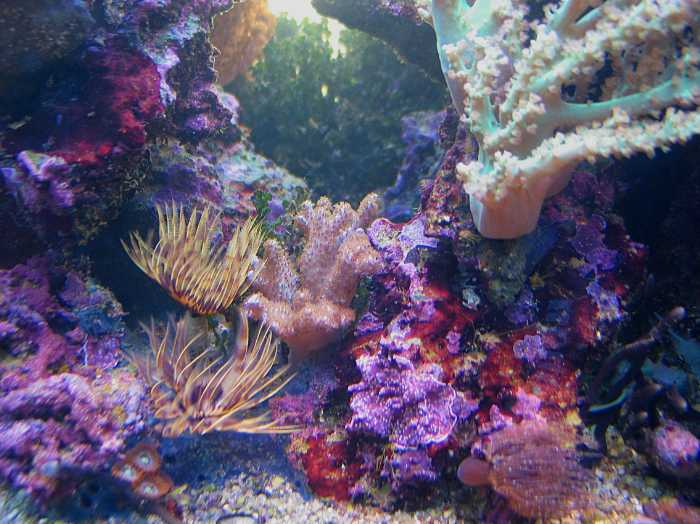

The backlight in these pics is the bright morning sun. This tank is directly in the sun of an East facing window.
Edited by Mark Peterson - June 11 2013 at 9:34am
|
Reefkeeping Tips, & quick, easy setup tricks:www.utahreefs.com/forum/forum_posts.asp?TID=9244 Pay it forward - become a paid WMAS member 
|
 |
Mark Peterson 
Paid Member


Joined: June 19 2002
Location: Murray
Status: Offline
Points: 21436
|
 Post Options Post Options
 Thanks(0) Thanks(0)
 Quote Quote  Reply Reply
 Posted: November 26 2005 at 11:29pm Posted: November 26 2005 at 11:29pm |
Now that you have read how to set up your reef aquarium, it's vital to know something about the water conditions that ensure a healthy aquarium. After Salinity and Temperature, the three most important water parameters for a Reef Aquarium are Alkalinity (Alk), Calcium (Ca) and Nitrate (NO3).
In my opinion, the best test kits for Alk and Ca are made by Salifert. The kits that test for NO3 are all basically the same, but over time you can see the effect of NO3 in the water by observing the condition of the coral polyps, so eventually you may be able to see at a glance that Nitrate is low, just by observing the coral.
Alk and Ca are components of reef aquarium water that become depleted as marine organisms live and grow. It is necessary to replace these components as they are used.
Nitrate is the third of four stages of what has been commonly labeled as the Nitrogen Cycle. It is not something to be replaced like Alk and Ca, but instead, Nitrate must be removed or preferably decomposed by the living components of a healthy reef filtration system. Because a high level of Nitrate is harmful to invertebrates such as coral and the plethora of water filtering organisms, it is the third important component of reef aquarium water chemistry. To discover more about the four stages of Nitrogen in the reef aquarium do some research on the Nitrogen Cycle. (Because of the methods described here, in your research it is okay to ignore the concepts that say aquariums must go through a long 4-8 week "cycle".  ) )
Adding Alkalinity
This is usually not necessary for a few months after setting up this Oolitic Sand and LBTR tank. But when testing indicates that Alk is at or below 8 dKH, it's time to start adding Alk. See a post below, regarding making your own incredibly inexpensive Alkalinity additive.
Adding Calcium
This is usually not necessary for a few months after setting up an Oolitic Sand and LBTR tank. But when testing indicates that Ca is below ~350 ppm, it's time to start adding Ca. See a post below for the way to do this, again affordably. 
Removing/Reducing Nitrate
This should occur as a natural process in a tank that has been set up according to the instructions in the post above, utilizing all that live stuff. If NO3 testing indicates levels of Nitrate have risen above 25 ppm then it's time to slow down, excercise patience and let the algae and nitrate reducing bacteria catch up to the available supply of Nitrate. (24/7 lighting really helps here.) Nitrate is a molecule called NO3. It is one Nitrogen atom with three Oxygen atoms bonded to it. Algae uses it and denitrifying bacteria break it down. Bacteria use the Oxygen for respiration which releases the Nitrogen from the molecule. The Nitrogen dissolves into the water and then moves out into the air at the water surface. This is one of the reasons for the emphasis on not covering the top of the tank with the traditional glass panels and for providing plenty of water movement/circulation. (Things that you may have already heard about, but if not, it would be a good idea to discover.) 
Edited by Mark Peterson - July 09 2006 at 5:23am
|
Reefkeeping Tips, & quick, easy setup tricks:www.utahreefs.com/forum/forum_posts.asp?TID=9244 Pay it forward - become a paid WMAS member 
|
 |
Suzy 
Guest

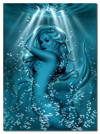
Joined: January 03 2003
Status: Offline
Points: 7377
|
 Post Options Post Options
 Thanks(0) Thanks(0)
 Quote Quote  Reply Reply
 Posted: November 27 2005 at 10:29am Posted: November 27 2005 at 10:29am |
|
FE+, NO3 & PO4?
|
 |
Mark Peterson 
Paid Member


Joined: June 19 2002
Location: Murray
Status: Offline
Points: 21436
|
 Post Options Post Options
 Thanks(0) Thanks(0)
 Quote Quote  Reply Reply
 Posted: December 14 2005 at 6:00am Posted: December 14 2005 at 6:00am |
I hope this information is helpful to you. Feel free to call the number below to get immediate answers to any and all reefkeeping questions.  Keep reading.... Keep reading....
Edited by Mark Peterson - November 26 2007 at 7:25am
|
Reefkeeping Tips, & quick, easy setup tricks:www.utahreefs.com/forum/forum_posts.asp?TID=9244 Pay it forward - become a paid WMAS member 
|
 |
Mark Peterson 
Paid Member


Joined: June 19 2002
Location: Murray
Status: Offline
Points: 21436
|
 Post Options Post Options
 Thanks(0) Thanks(0)
 Quote Quote  Reply Reply
 Posted: February 15 2006 at 10:39pm Posted: February 15 2006 at 10:39pm |
Directions to Utah Oolitic Sand and Lake Bonneville Tufa Rock. On page 2 of this thread is a nice arial pic/map, so keep on reading  ) )
1. The sand is easier to find than rock. Here is a link to the Utah Geological Survey website which first led us to the sand. http://geology.utah.gov/utahgeo/rockmineral/collecting/oolit ic.htm The directions on that site mention a stop sign. There is no stop sign but there is a sign pointing left to Broken Arrow Salt. Turn left at that road.
Unfortunately, the sand dunes disappeared from the south side of the road. Not to worry, there is plenty on the opposite side of the road where the dunes continue to the north. Here is a pic looking SW at the vanished dunes! 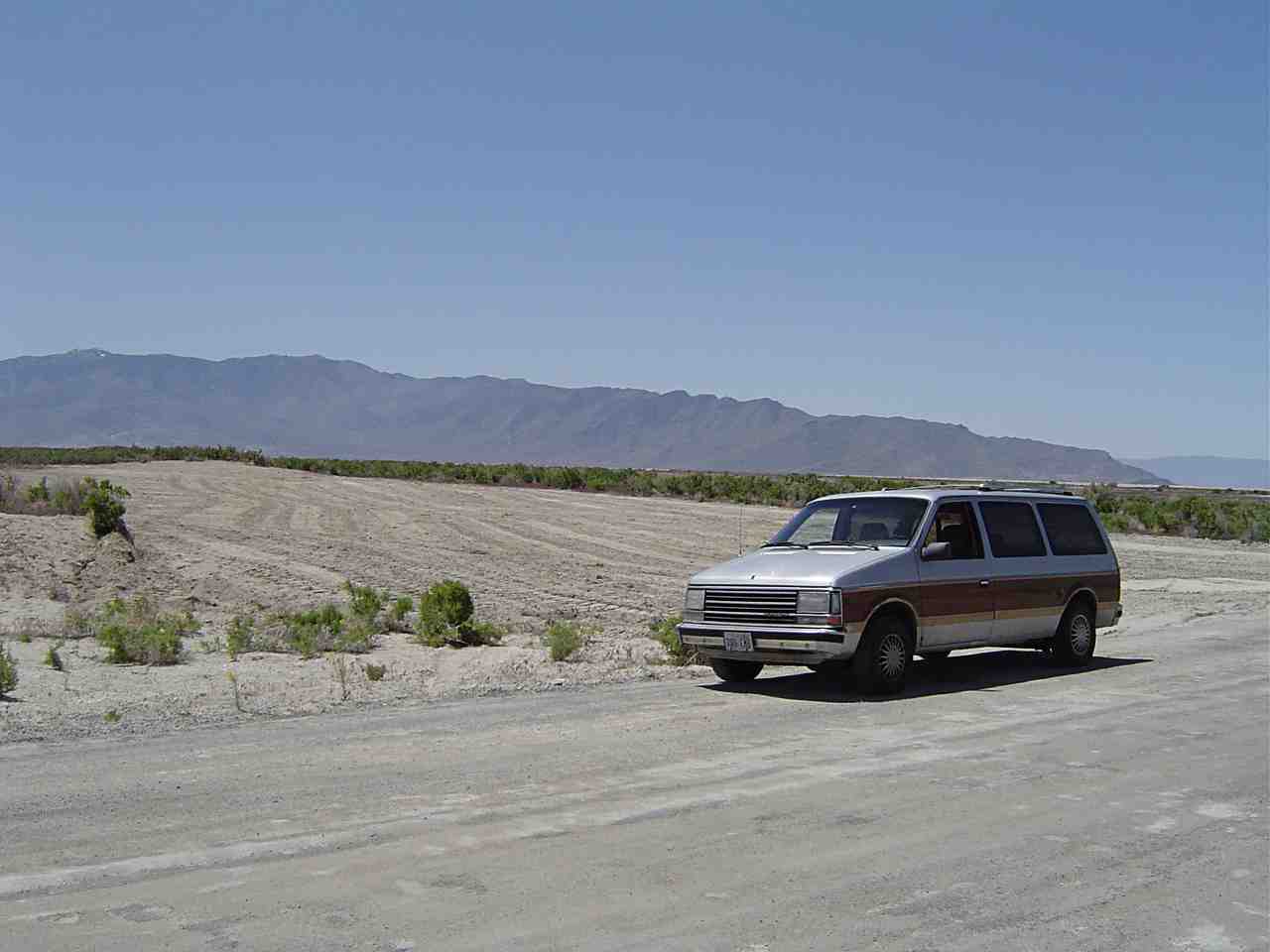
Below is a pic, in the winter, of the north side of the road exactly opposite from the location in the pic above. Collecting sand can be fun any time of year, but not right after a heavy rain.
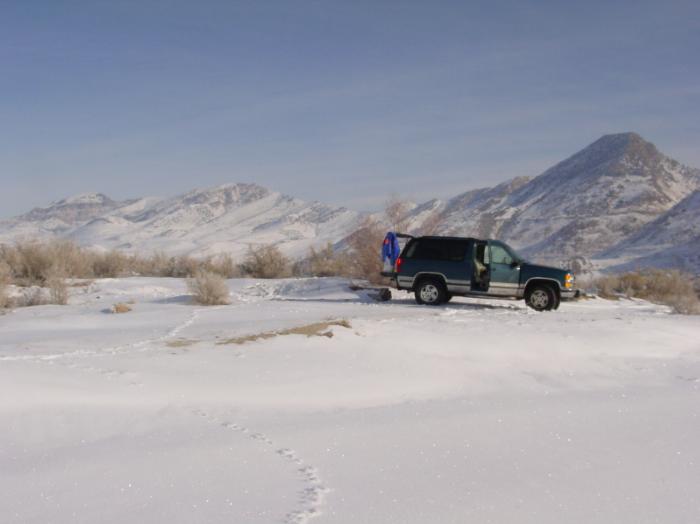
2. LBTR
Edit> Please see the Reefkeeping Tip above for my comments about Utah Rock/LBTR.
There are several spots. The closest place is almost exactly north of the sand collection area. Rather than turning left toward Broken Arrow Salt, continue a half mile or so to some trails off to the left that run through the dunes to the West. (Oolitic sand dunes!) Follow these 4x4 trails to the mud flats. Digging with a shovel in the mud along some drainage ditches once revealed LBTR, but over the years it has all been removed by hobbyists.
Other LBTR has been found along the terraces left by Lake Bonneville at various spots on the slopes of Stansbury Island, on the West slopes of the Oquirrh Mountains toward Tooele and further out I-80 at the exits marked "Lakeside - Military Exit" and this:
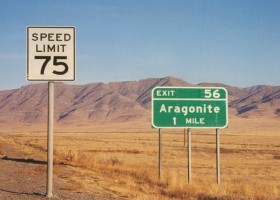 (This is the sign you would see if traveling from Wendover.) (This is the sign you would see if traveling from Wendover.)
Edited by Mark Peterson - May 27 2014 at 10:12am
|
Reefkeeping Tips, & quick, easy setup tricks:www.utahreefs.com/forum/forum_posts.asp?TID=9244 Pay it forward - become a paid WMAS member 
|
 |
bbeck4x4 
Guest


Joined: June 22 2005
Location: Spanish Fork
Status: Offline
Points: 2378
|
 Post Options Post Options
 Thanks(0) Thanks(0)
 Quote Quote  Reply Reply
 Posted: February 15 2006 at 10:48pm Posted: February 15 2006 at 10:48pm |
hey and I though I was going too fast at three weeks for a seahorse tank, 
my first tank a little more than a year ago took 10 weeks following the advice of a lfs. 
glad I found this site when I did 
Brian
|
|
Family Portraits /Google trusted Photographer for Google Maps for Businesses
|
 |
aquablue 
Guest


Joined: December 29 2005
Location: Roy UT
Status: Offline
Points: 389
|
 Post Options Post Options
 Thanks(0) Thanks(0)
 Quote Quote  Reply Reply
 Posted: February 17 2006 at 2:29pm Posted: February 17 2006 at 2:29pm |
my seahorse tank was a 3 day project, day 1 was basic setup lights, filter, sand, rock and water, day 2 was circulation, day 3 was seahorse adding.. but it was a cheat cause it was live sand from my big tank, water from my big tank, and LR from my big tank. 
|
|
29G Rimless BioCube | DIY LED
12G Nano Cube | DIY LED
Member of GCFB
|
 |
invision 
Guest


Joined: February 18 2006
Location: United States
Status: Offline
Points: 17
|
 Post Options Post Options
 Thanks(0) Thanks(0)
 Quote Quote  Reply Reply
 Posted: February 18 2006 at 12:57am Posted: February 18 2006 at 12:57am |
Where do I find this rock and sand in utah?
I live in Ogden.
Thanks
Jason
|
|
29 Gallon Saltwater with Eclipse 3 hood/filter/lighting.
Also Just setup a 10 gallon for pods
www.invisioncomputers.com
|
 |
Rhine Lenhart 
Guest


Joined: October 09 2005
Location: Saint Vincent
Status: Offline
Points: 890
|
 Post Options Post Options
 Thanks(0) Thanks(0)
 Quote Quote  Reply Reply
 Posted: February 18 2006 at 9:16am Posted: February 18 2006 at 9:16am |
 invision wrote: invision wrote:
Where do I find this rock and sand in utah?
I live in Ogden.
Thanks
Jason
|
Mark is usually the best source he is the sand and rock he is the sand and rock . . . .
But i'm sure other replies will follow.
|
|
55 Gal Reef.
30 Gal Fuge.
957-9197
2007 presidency
|
 |
Mark Peterson 
Paid Member


Joined: June 19 2002
Location: Murray
Status: Offline
Points: 21436
|
 Post Options Post Options
 Thanks(0) Thanks(0)
 Quote Quote  Reply Reply
 Posted: February 18 2006 at 10:18am Posted: February 18 2006 at 10:18am |
ALKANITY AND CALCIUM
The addition of supplements is very common in the hobby. The first and most important supplement to consider is dripping Kalkwasser at night as top off. This supplement is not only a good source of equal amounts of Alk and Ca, it also has the added benefit of stabilizing pH. At night when photosynthesis switches off, algae becomes an oxygen consumer and Carbon Dioxide producer. This drop in pH is a common cause of stress, disease and sometimes death of fish, nor is it good for inverts, including coral. Kalkwasser is a long standing proven method for keeping a well maintained reef aquarium.
If the tank has enough growth that Kalkwasser cannot add sufficient Alk and Ca, the second supplements to consider are a 2-part solution of Alkalinity and Calcium. The surprising thing to new hobbyists is that these supplements can be made at home with some ordinary household products, Baking Soda and Ice Melt. Here below I have written about how to do it and here is a link to an article by the hobby "guru" of chemistry Randy Holmes-Farley http://www.reefkeeping.com/issues/2006-02/rhf/. These are the most important and yet the easiest supplements that will do the most good for a reef tank. I highly recommend it.
The third and final method of adding Alk and Ca is the "Calcium Reactor". So called because it is a semi-automated way to give the stony coral the Calcium they need for skeleton growth. It's not an accurate name but it has stuck so we use it. A better name would be the "Carbonate Reactor". It adds Calcium and Alkalinity by dissolving Aragonite, the same substance we use for sand! The resulting Carbonates in solution are pumped into the tank at a rate set by the hobbyist. This is the most complicated method of adding Alk and Ca and is practical only for those tanks with a large percentage of stony coral. It's downsides are cost, the inadvertant decrease of pH, the complications of setting and continual monitering of several flow rates and the need to bump up the Alkalinity periodically with the Alk side of the 2-part solution.
There is one thing to consider, the more we ignorantly mess with the chemistry of our tanks, the worse they fare. A water change is always the safest way to reduce any excess.
Making and adding Alkalinity and Calcium to the reef aquarium
Alkalinity: 4 parts Baking soda and 1 part Soda Ash/Washing Soda. Soda Ash is made by baking Baking Soda in a glass baking dish at ~400 for an hour or so. Dissolve as much of this as will dissolve in purified water, then add it regularly along with doing Alkalinity testing to be sure of dosing the right amount. The desired range is 8-14 dKH or it's equivalent in meq/l or ppm.
Calcium: Dissolve as much Calcium Chloride (Peladow brand ice melt or CaCl2 from a chemical shop) as will dissolve in purified water. Dose it separately from the Alkalinity additive. Mixing the two together or adding them to the aquarium where they can mix too soon is ineffective and forms solid Calcium Carbonate in a chemical reaction typically described as "snowing". But dose this Calcium additive on the same schedule as the Alkalinity, using an amount based on the need as determined by Calcium testing. 350-450ppm is the desired range.
Determining the correct amount to dose: For example, taking a 100 gal tank, I would start by testing the Alk and Ca levels. If either are out of the desired range, I would add ~1/4 cup of the needed component solution, then test the next day to see what difference it made, if any. Then adjust the dosage accordingly, testing and watching the levels daily (or weekly if you are lazy like me  ) until I had figured out about how much to add to replce what the tank is using.
Tip: Dosing at the same time as feeding, helps keep it fairly regular and consistent.
Tip: Reef aquariums can handle it if the dosage moderately exceeds the levels of the desired range. Simply stop dosing for a few days and let the tank take care of the extra through natural processes. If a large amount is accidentally added (dang kids  ) a partial water change can help alleviate a problem.
Edited by Mark Peterson - October 09 2016 at 3:17pm
|
Reefkeeping Tips, & quick, easy setup tricks:www.utahreefs.com/forum/forum_posts.asp?TID=9244 Pay it forward - become a paid WMAS member 
|
 |
dpdecaro 
Guest

Joined: December 24 2005
Location: United States
Status: Offline
Points: 14
|
 Post Options Post Options
 Thanks(0) Thanks(0)
 Quote Quote  Reply Reply
 Posted: March 05 2006 at 11:45am Posted: March 05 2006 at 11:45am |
hello
I was wondering if i should switch my sand out i have in my little 18 gal nano reef. I just went and bought some play sand from sutherlands and put in there. I have had success with this sand in my bigger tank back home but is is a gray ish color. I have not seeded it yet. I put a couple piece of lr i bought from bird word (really expensive) but nothing else. If i should switch is there a possibility that some one could get some for and and some dead rock i could maybe buy from them. THanks for the information. I wish i saw this thread right after i moved down here.
David
|
 |
Mark Peterson 
Paid Member


Joined: June 19 2002
Location: Murray
Status: Offline
Points: 21436
|
 Post Options Post Options
 Thanks(0) Thanks(0)
 Quote Quote  Reply Reply
 Posted: May 19 2006 at 9:31am Posted: May 19 2006 at 9:31am |
Play sand is usually silica. It is not made of Calcium Carbonate. Calcium Carbonate is the same thing as LR from the ocean. Utah Oolitic Sand and LBTR are Calcium Carbonate. This is essential to the proper functioning of a reef aquarium.
I usually have lots of Utah Oolitic Sand and LBTR at my place for anyone that wants it. All I ask is a little gas money to help with my next collecting trip. Simply call the phone number below to arrange a visit. I also have LS, LW, LR and Macroalgae. I give it away in reasonable quantities, sell it cheap in larger amounts. Simply call the phone number below to arrange a visit. I also have LS, LW, LR and Macroalgae. I give it away in reasonable quantities, sell it cheap in larger amounts. 
Edited by Mark Peterson - July 09 2006 at 5:40am
|
Reefkeeping Tips, & quick, easy setup tricks:www.utahreefs.com/forum/forum_posts.asp?TID=9244 Pay it forward - become a paid WMAS member 
|
 |
griffith 
Guest


Joined: May 02 2006
Location: Centerville
Status: Offline
Points: 2300
|
 Post Options Post Options
 Thanks(0) Thanks(0)
 Quote Quote  Reply Reply
 Posted: May 19 2006 at 9:40am Posted: May 19 2006 at 9:40am |
Hey Mark,
Thanks for the great info.
Linn
|
 |
Adam Blundell 
Presidency


Joined: June 24 2002
Location: Davis County
Status: Offline
Points: 18526
|
 Post Options Post Options
 Thanks(0) Thanks(0)
 Quote Quote  Reply Reply
 Posted: May 19 2006 at 9:43am Posted: May 19 2006 at 9:43am |
Play sand is usually silica. It is not made of Calcium Carbonate. Calcium Carbonate is the same thing as LR from the ocean. Utah Oolitic Sand and LBTR are Calcium Carbonate. This is essential to the proper functioning of a reef aquarium.
I'm still not convinced of this. I think silica sand, legos, tufa rock, anything can be used well in an aquarium. Jon doesn't think that aragonite even dissolves in our tanks (but I think it does). Regardless, who cares?
Adam
|
|
Come to a meeting, they’re fun!
|
 |
jfinch 
Guest


Joined: March 06 2003
Location: Pleasant Grove
Status: Offline
Points: 7067
|
 Post Options Post Options
 Thanks(0) Thanks(0)
 Quote Quote  Reply Reply
 Posted: May 19 2006 at 12:08pm Posted: May 19 2006 at 12:08pm |
I agree with Adam about silica sand. And I still don't think aragonite sand dissolves to any apprecable extent  .
|
|
|
 |
Adam Blundell 
Presidency


Joined: June 24 2002
Location: Davis County
Status: Offline
Points: 18526
|
 Post Options Post Options
 Thanks(0) Thanks(0)
 Quote Quote  Reply Reply
 Posted: May 19 2006 at 1:25pm Posted: May 19 2006 at 1:25pm |
You see Jon here is the problem. You and I disagree on the solubility of aragonite and the conditions of our sand beds. Unfortunately I know that you are smarter than I am. Therefore I don't usually bring up this topic because I know I must somehow be wrong.
But don't tell anyone.  Adam
|
|
Come to a meeting, they’re fun!
|
 |
jfinch 
Guest


Joined: March 06 2003
Location: Pleasant Grove
Status: Offline
Points: 7067
|
 Post Options Post Options
 Thanks(0) Thanks(0)
 Quote Quote  Reply Reply
 Posted: May 19 2006 at 2:16pm Posted: May 19 2006 at 2:16pm |
It doesn't really matter anyway... in the end it's just an academic discussion. If your sand dissolves enought to keep your calcium and alk at desired levels then good for you. Otherwise, use some other method (bionic, kalk, calcium reactors, etc) to supplement your dissolving sand. I know in my system, my sand does not dissolve. I've got the same amount of sand today that I had 2 yrs ago. But maybe I don't have a deep enough sandbed :shrug:.
|
|
|
 |
Mark Peterson 
Paid Member


Joined: June 19 2002
Location: Murray
Status: Offline
Points: 21436
|
 Post Options Post Options
 Thanks(0) Thanks(0)
 Quote Quote  Reply Reply
 Posted: July 09 2006 at 5:49am Posted: July 09 2006 at 5:49am |
I agree. It seems to me that sand and rock may dissolve, but not fast enough to keep the stony coral growing like most of us want. We see a much healthier aquarium and much faster growth of Coralline algae, stony coral, clams and even soft coral when Alk, Ca, and Mg are supplemented according to needs as determined by testing.
But I cannot believe that a tank with Lego's for substrate would do as well as one with Aragonite/CaCO3 sand.
Note: a post above has been edited to provide info regarding making your own Alk and Ca additives and how to determine dosage.
Edited by Mark Peterson - July 09 2006 at 5:59am
|
Reefkeeping Tips, & quick, easy setup tricks:www.utahreefs.com/forum/forum_posts.asp?TID=9244 Pay it forward - become a paid WMAS member 
|
 |
Redrock 
Guest


Joined: April 12 2006
Location: United States
Status: Offline
Points: 141
|
 Post Options Post Options
 Thanks(0) Thanks(0)
 Quote Quote  Reply Reply
 Posted: September 06 2006 at 4:45pm Posted: September 06 2006 at 4:45pm |
I am so ready to make the trip out west to gather some sand and rock. Old Lake Bonneville, who'da thunk it?
Hey I wish black lava rock was a good base rock substitue, I know where VERY MUCH of this stuff sits.
Edited by Redrock - September 06 2006 at 4:46pm
|
 |